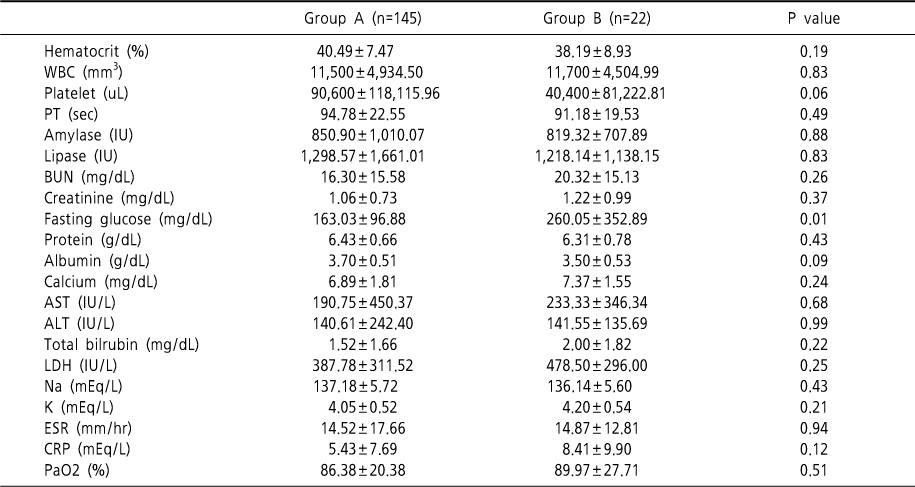Department of Internal Medicine, Ewha Womans University School of Medicine, Seoul, Korea.
1Vievis Namuh Hospital, Seoul, Korea.
Copyright © 2012. Ewha Womans University School of Medicine
Group A (mild acute pancreatitis), without morbidity, without organ failure. Group B (aggressive mild acute pancreatitis), with morbidity, without organ failure. BMI, body mass index; ICU, intensive care unit.

Group A (mild acute pancreatitis), without morbidity, without organ failure. Group B (aggressive mild acute pancreatitis), with morbidity, without organ failure.

Group A (mild acute pancreatitis), without morbidity, without organ failure. Group B (aggressive mild acute pancreatitis), with morbidity, without organ failure.

Group A (mild acute pancreatitis), without morbidity, without organ failure. Group B (aggressive mild acute pancreatitis), with morbidity, without organ failure. CT, computed tomography; SOFA, Sepsis-related Organ Failure Assessment; APACHE, Acute Physiology and Chronic Health Evaluation; BISAP, Bedside Index of Severity in Acute Pancreatitis.


Suggested new classification of acute pancreatitis
MAP, mild acute pancreatitis; AMAP, aggressive mild acute pancreatitis.
General characteristics of patients of mild form acute pancreatitis
Group A (mild acute pancreatitis), without morbidity, without organ failure. Group B (aggressive mild acute pancreatitis), with morbidity, without organ failure. BMI, body mass index; ICU, intensive care unit.
Characteristics of patients of mild form acute pancreatitis based on underlying diseases
Group A (mild acute pancreatitis), without morbidity, without organ failure. Group B (aggressive mild acute pancreatitis), with morbidity, without organ failure.
Laboratory findings of patients of mild form acute pancreatitis
Group A (mild acute pancreatitis), without morbidity, without organ failure. Group B (aggressive mild acute pancreatitis), with morbidity, without organ failure.
Clinical scoring systems and index of mild form acute pancreatitis
Group A (mild acute pancreatitis), without morbidity, without organ failure. Group B (aggressive mild acute pancreatitis), with morbidity, without organ failure. CT, computed tomography; SOFA, Sepsis-related Organ Failure Assessment; APACHE, Acute Physiology and Chronic Health Evaluation; BISAP, Bedside Index of Severity in Acute Pancreatitis.
MAP, mild acute pancreatitis; AMAP, aggressive mild acute pancreatitis.
Group A (mild acute pancreatitis), without morbidity, without organ failure. Group B (aggressive mild acute pancreatitis), with morbidity, without organ failure. BMI, body mass index; ICU, intensive care unit.
Group A (mild acute pancreatitis), without morbidity, without organ failure. Group B (aggressive mild acute pancreatitis), with morbidity, without organ failure.
Group A (mild acute pancreatitis), without morbidity, without organ failure. Group B (aggressive mild acute pancreatitis), with morbidity, without organ failure.
Group A (mild acute pancreatitis), without morbidity, without organ failure. Group B (aggressive mild acute pancreatitis), with morbidity, without organ failure. CT, computed tomography; SOFA, Sepsis-related Organ Failure Assessment; APACHE, Acute Physiology and Chronic Health Evaluation; BISAP, Bedside Index of Severity in Acute Pancreatitis.